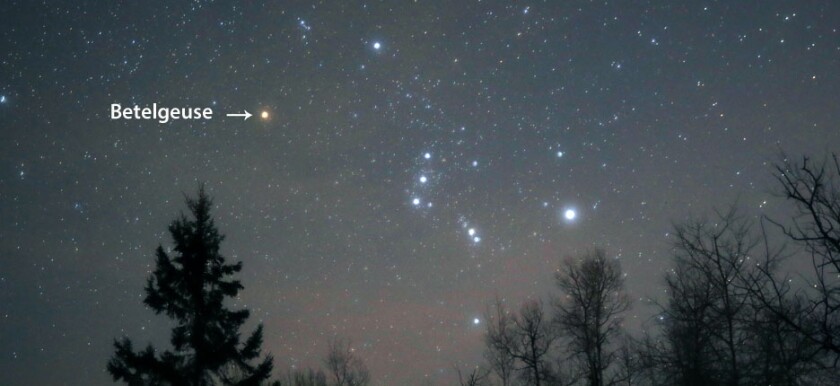Wouldn't it be nice to know when a star is going to blow up? We have a pretty good handle on what types of stars could explode as supernovae, but timing's another thing. Astronomers are being honest when they say "it could be tonight or 10,000 years from now." Still, the answer leaves us wanting.

Betelgeuse is a great example of a star we're confident will explode as a supernova. This famous red supergiant is about 764 times bigger than the sun and shines 14,000 times brighter at peak light. Subbed in place of the sun, its gaseous surface would extend nearly to Jupiter.
Betelgeuse and its kin burn hot compared to the sun because they're so much more massive. All that internal pressure cranks up the temperature, causing the star to devour its nuclear fuel faster than a gas-guzzling Chevy Suburban. Smaller, cooler stars are more frugal. With luck, Betelgeuse might live for 10 million years or so. Stars like the sun on the other hand faithfully produce energy for 10 billion years or more.
One of the side benefits of a long stellar life is the additional time afforded any planets orbiting a star to evolve life. If Betelgeuse has such worlds they're likely to be barren.

Stars creates energy by combining elements through the process of nuclear fusion, starting with the simplest and most abundant element of all: hydrogen. In the 30-million-degree (F) heat of the sun's core, hydrogen atoms fuse to form helium, releasing energy in the process. That energy reaches its surface and showers us with sunshine and warmth.
ADVERTISEMENT
Eventually, a star's hydrogen supply runs dry. Then it turns to burning its own ash, fusing helium into carbon. The more massive the star, the more elements it can fuse. After carbon comes oxygen, followed by neon, silicon and others until it arrives at iron.

Iron's a star-killer. You can't fuse it to release more energy like the others — the star suddenly reaches a dead end. Without continued heat and outward pressure to fight back its own self-gravity, it collapses inward. This initiates a shock wave that reverberates back out through the star, tearing it apart in a catastrophic explosion called a supernova. In child-speak — "star go boom!"

The sun is too small to cook up the really heavy stuff like silicon let alone iron. Its end will be a more peaceful affair. Instead of exploding it will expel its outer layers, while the core will persist as a white dwarf star the size of the Earth. Things get really quiet after that. Like an ember, the former sun will slowly cool over the next few trillion years until reaching it final state as a black dwarf.

What if a star could send a signal to alert us to its imminent collapse? Maybe they are. A team of astronomers in the UK and France discovered that when it comes Betelgeuse-like red supergiants, they can tip us off. To appreciate their result, first know that stars release material into space all the time as stellar winds. Even the sun blows a steady breeze of particles into space. Giant stars like Betelgeuse do it with greater strength and volume!
The outward pressure from Betelgeuse's own radiation pushes against dust and gases in the star's outer envelope, lofting them into space. Because the star's surface is so far from its core, gravity holds it only weakly, so even a gently push sloughs off considerable mass.
Supergiants can shuck off up to half their total "possessions" in a lifetime, something that would impress even Marie Kondo . They can lose that material gradually or through sudden, massive outbursts caused by instabilities deep within the star. Either way, a shroud of dust blocks the light of the star and dims it.

The group examined photographs of several dozen red supergiants taken within 10 years of their supernovae blow-ups. They discovered that shortly before the stars met their demise, they became very faint and red, an indication of a rapid and massive release of dust and gas.
If the fading were due to a steady wind, the stars would be red and faint for many decades before exploding. Whatever caused the sudden dimming "must do it on a very rapid timescale," the authors write. "Within a year of core-collapse."
ADVERTISEMENT
They concluded that the sign of an imminent explosion of a red supergiant would be a radical change in the star's visible and infrared light on timescales of less than a month. When Betelgeuse faded suddenly in 2019 we all wondered if the end was near. Now that we have a new yardstick, I look forward to a Betelgeuse-goes-kablooey forecast. Soon, please, if possible.











